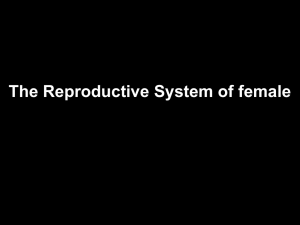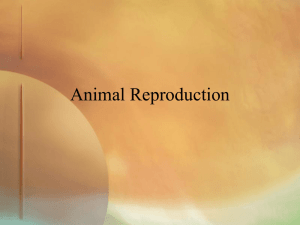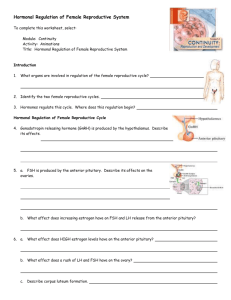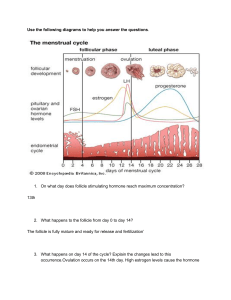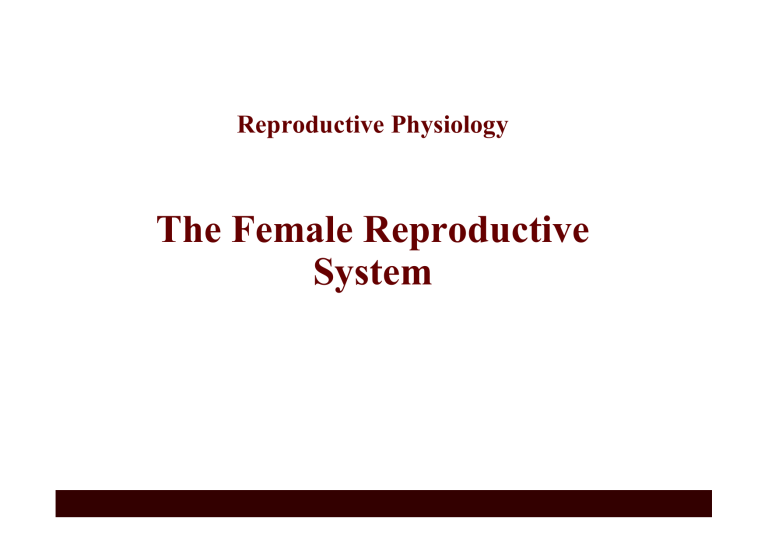
Reproductive Physiology The Female Reproductive System Female Reproductive Anatomy • Ovaries are the primary female reproductive organs • Make female gametes (ova) • Secrete female sex hormones (estrogen and progesterone) • Accessory ducts include uterine tubes, uterus, and vagina • Internal genitalia – ovaries and the internal ducts • External genitalia – external sex organs Female Reproductive Anatomy The Ovaries Ovaries Ovary: histology Ovarian Cycle • Monthly series of events associated with the maturation of an egg • Starts at puberty (beginning of the menstrual cycles is termed menarche • Average duration 28 days (20-45 days) • Phases of ovarian cycle: • Follicular phase – period of follicle growth (days 1–14) • Luteal phase – period of corpus luteum activity (days 14–28) • Ovulation occurs midcycle (day 14) Follicular Phase • Upon FSH stimulation, (6-12) primordial follicles becomes a primary follicle (one layer of cells) • Primary follicle then becomes a secondary follicle • The theca and granulosa cells cooperate to produce estrogens • The antrum is formed • Before ovulation, only one follicle grows and the rest (5-11) becomes atretic Follicular Phase (hormonal regulation) • GnRH rises in response to a decline in inhibin and sex steroids • GnRH stimulates rise in pituitary FSH & LH secretion. • FSH stimulates new follicle growth • LH induces thecal cell growth, vascularization & androgen synthesis • FSH stimulates granulosa cell production of E2 & LH receptor Ovarian Cycle Ovulation • Rapidly rising estrogen levels stimulate LH surge (positive feedback-GnRH sensitization) about 2 days before ovulation • LH surge triggers ovulation • Ovulation occurs when the ovary wall ruptures and expels the secondary oocyte • Mittelschmerz – a twinge of pain sometimes felt at ovulation Luteal Phase • After ovulation, the ruptured follicle collapses, granulosa cells enlarge, and along with internal thecal cells, form the corpus luteum (LH action) • The corpus luteum secretes progesterone and estrogen • If pregnancy does not occur, the corpus luteum degenerates in 12 days after ovulation, leaving a scar (corpus albicans) • If pregnancy does occur, the corpus luteum produces hormones until the placenta takes over that role (at about 3 months) Luteal Phase (cont.) • Estrogens and progesterones shut off FSH and LH release • Days 26-28 – decline of the ovarian hormones • Ends the blockade of FSH and LH • The cycle starts anew Feedback Mechanisms in Ovarian Function Hormonal Interactions During the Ovarian Cycle The Hormonal Regulation of the Female Reproductive Cycle Uterine (Menstrual) Cycle • Series of cyclic changes that the uterine endometrium goes through each month in response to ovarian hormones in the blood • Days 1-5: Menstrual phase – uterus sheds all but the deepest part of the endometrium • Days 6-14: Proliferative (preovulatory) phase – endometrium rebuilds itself • Days 15-28: Secretory (postovulatory) phase – endometrium prepares for implantation of the embryo Menses • If fertilization does not occur, progesterone levels fall, depriving the endometrium of hormonal support • Spiral arteries kink and go into spasms and endometrial cells begin to die (prostaglandin effect) • The functional layer begins to digest itself • Spiral arteries constrict one final time then suddenly relax and open wide • The rush of blood fragments weakened capillary beds and the functional layer sloughs • Fibrinolysin is produced to prevent clotting Proliferative Phase (estrogen phase) • preovulation • Rising levels of estrogens cause reepithelialization of the endometrium, vascularization, and growth of endometrial glands • At the time of ovulation, the endometrium is 3-5 mm thick Secretory Phase (progesterone phase) • After ovulation • Estrogen and progesterone levels are high • More growth, progesterone causes swelling and secretory development of the endometrium • One week after ovulation, the endometrium is 5-6 mm thick • Provide appropriate conditions for fertilized ovum Overview of the Menstrual Cycle The Hormonal Regulation of the Female Reproductive Cycle Effects of Estrogens • Estrogen levels rise during puberty • Change of vaginal epithelium from cuboidal to stratified • Promote oogenesis and follicle growth in the ovary • Exert anabolic effects on the female reproductive tract • Uterine tubes, uterus, and vagina grow larger and become functional • Uterine tubes and uterus exhibit enhanced motility • Vaginal mucosa thickens and external genitalia mature • In breast, estrogen causes development of stromal cells, ductile system, and fat deposition Effects of Estrogens (cont.) • Estrogens cause increased osteoblastic activity as well as closure of epiphyseal plates • The skin is thicker, smoother, and more vascular Estrogen-Induced Secondary Sex Characteristics • Growth of the breasts • Increased deposition of subcutaneous fat, especially in the hips and breasts • Widening and lightening of the pelvis • Growth of axillary and pubic hair Effects of Progesterone • Promote secretory changes in the uterus • Increased secreion of fallopian tubes • Promote development of ducts and alveoli of the breast Female Sexual Response • Like in male, depends on psychic and local stimulation • The clitoris, vaginal mucosa, and breasts engorge with blood • Activity of vestibular glands lubricates the vestibule and facilitates entry of the penis • Orgasm – accompanied by muscle tension, increase in pulse rate and blood pressure, and rhythmical contractions of the uterus • Females do not have a refractory period after orgasm and can experience multiple orgasms in a single sexual experience • Orgasm is not essential for conception Menopause • At age 40-50 years • Ovulation and menses cease entirely • Without sufficient estrogen, reproductive organs and breasts atrophy • Irritability and depression result • Skin blood vessels undergo intense vasodilation (hot flushes occur) • Gradual thinning of the skin and bone loss • Males have no equivalent to menopause

